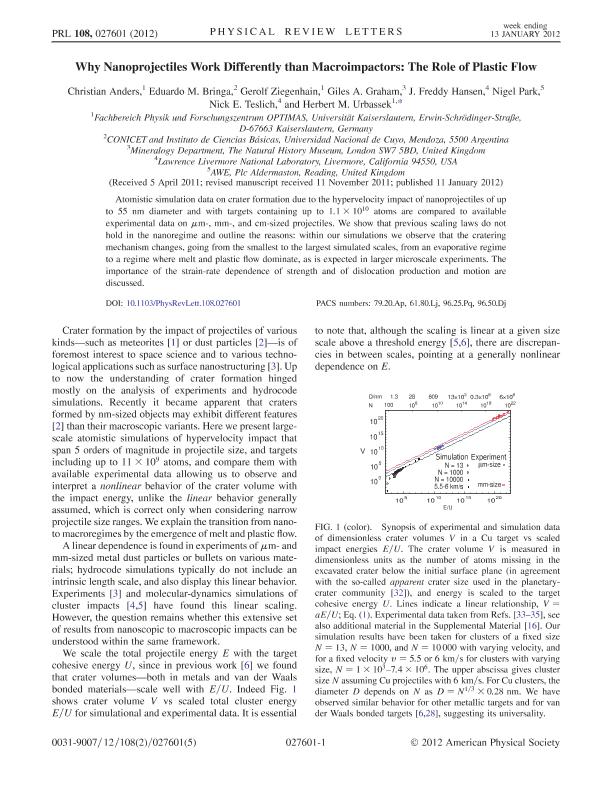Mostrar el registro sencillo del ítem
dc.contributor.author
Anders, Christian

dc.contributor.author
Bringa, Eduardo Marcial

dc.contributor.author
Ziegenhain, Gerolf

dc.contributor.author
Graham, Giles A.
dc.contributor.author
Hansen, J. Freddy
dc.contributor.author
Park, Nigel
dc.contributor.author
Teslich, Nick E.
dc.contributor.author
Urbassek, Herbert M.

dc.date.available
2023-06-05T13:02:59Z
dc.date.issued
2012-01
dc.identifier.citation
Anders, Christian; Bringa, Eduardo Marcial; Ziegenhain, Gerolf; Graham, Giles A.; Hansen, J. Freddy; et al.; Why nanoprojectiles work differently than macroimpactors: The role of plastic flow; American Physical Society; Physical Review Letters; 108; 2; 1-2012; 27601-27605
dc.identifier.issn
0031-9007
dc.identifier.uri
http://hdl.handle.net/11336/199500
dc.description.abstract
Atomistic simulation data on crater formation due to the hypervelocity impact of nanoprojectiles of up to 55 nm diameter and with targets containing up to 10^10 atoms are compared to available experimental data on micron-, mm-, and cm-sized projectiles. We show that previous scaling laws do not hold in the nanoregime and outline the reasons: within our simulations we observe that the cratering mechanism changes, going from the smallest to the largest simulated scales, from an evaporative regime to a regime where melt and plastic flow dominate, as is expected in larger microscale experiments. The importance of the strain-rate dependence of strength and of dislocation production and motion are discussed.
dc.format
application/pdf
dc.language.iso
eng
dc.publisher
American Physical Society

dc.rights
info:eu-repo/semantics/openAccess
dc.rights.uri
https://creativecommons.org/licenses/by-nc-sa/2.5/ar/
dc.subject
craters
dc.subject
molecular dynamics
dc.subject.classification
Física de los Materiales Condensados

dc.subject.classification
Ciencias Físicas

dc.subject.classification
CIENCIAS NATURALES Y EXACTAS

dc.title
Why nanoprojectiles work differently than macroimpactors: The role of plastic flow
dc.type
info:eu-repo/semantics/article
dc.type
info:ar-repo/semantics/artículo
dc.type
info:eu-repo/semantics/publishedVersion
dc.date.updated
2023-06-05T11:59:36Z
dc.journal.volume
108
dc.journal.number
2
dc.journal.pagination
27601-27605
dc.journal.pais
Estados Unidos

dc.journal.ciudad
New York
dc.description.fil
Fil: Anders, Christian. Universitat Kaiserslautern; Alemania
dc.description.fil
Fil: Bringa, Eduardo Marcial. Universidad Nacional de Cuyo. Facultad de Ciencias Exactas y Naturales; Argentina. Consejo Nacional de Investigaciones Científicas y Técnicas. Centro Científico Tecnológico Conicet - Mendoza; Argentina
dc.description.fil
Fil: Ziegenhain, Gerolf. Universitat Kaiserslautern; Alemania
dc.description.fil
Fil: Graham, Giles A.. Natural History Museum; Reino Unido
dc.description.fil
Fil: Hansen, J. Freddy. Lawrence Livermore National Laboratory; Estados Unidos
dc.description.fil
Fil: Park, Nigel. No especifíca;
dc.description.fil
Fil: Teslich, Nick E.. Lawrence Livermore National Laboratory; Estados Unidos
dc.description.fil
Fil: Urbassek, Herbert M.. Universitat Kaiserslautern; Alemania
dc.journal.title
Physical Review Letters

dc.relation.alternativeid
info:eu-repo/semantics/altIdentifier/url/https://journals.aps.org/prl/abstract/10.1103/PhysRevLett.108.027601
dc.relation.alternativeid
info:eu-repo/semantics/altIdentifier/doi/http://dx.doi.org/10.1103/PhysRevLett.108.027601
Archivos asociados
